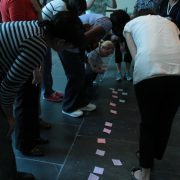Mission Possible: Creative Control
Special thanks to our Smithsonian Affiliations summer intern Neema Amadala (University of Calgary) for participating in the Smithsonian’s EdLab Teacher workshops in order to share her experience with us. Here, Neema Amadala reflects on what participating in these workshops meant to her.
Imagine being able to interact with a painting and the museum in a completely different manner than usual. Instead of simply standing and admiring the painting, we studied and questioned its possible meaning, we created our own narrative about the painting, we didn’t let someone else interpret it for us. This type of experience can be adapted to any museum or any classroom; this approach makes field trips part of the learning experience not just an afterthought. Students unleash their creativity instead of viewing the museum as yet another excuse to leave the classroom: museums open the doors to learning and adventure.
Each EdLab workshop has a theme for the week and a mission for the day but gives creative control to each individual group allowing you to choose what topics interest you and what you would like to explore further. This format can be used in any setting and made me realize how much flexibility educators have with technology. My favorite creation of the week was the comic book our group created based on a Thomas Hart Benton painting in Smithsonian’s Museum of American Art.

“Achelous and Hercules,” 1947, Thomas Hart Benton (1889-1975), tempera and oil on canvas mounted on plywood, 62 7/8 x 264 1/8 in. (159.6 x 671.0 cm.), Smithsonian American Art Museum, Gift of Allied Stores Corporation, and museum purchase through the Smithsonian Institution Collections Acquisition Program, 1985.2.
As a child, I often heard about putting myself in other people’s shoes. For a child this is a difficult thing to imagine: how do I wear the shoes of someone else? The older you get, the better you understand the meaning behind the phrase. It’s still hard to imagine until you talk to the individual, hear their struggles and the challenges they face. This workshop enabled me to understand the difficulties educators face when trying to implement new technologies in their classroom but their presence in the workshop shows their determination to find ways to continue innovating. Innovate on educators, innovate on!
For more information about the Smithsonian EdLab program, click here.

Comic the EdLab workshop participants created













